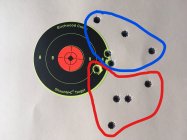I have measured case volume and weight for samples of every brass prep I've done for the last several years, then prepared graphs of case volume versus case weight. These analyses have covered a variety of different brands of brass (Lapua, Norma, Alpha, Starline, and PPU, to name a few) and three different cartridges (.223 Rem, .308 Win, .30-06). As assessed using a correlation coefficient, every single brass prep has shown a strong linear correlation between case volume and case weight,
every single one. Other reloaders can argue all they want about the potential relationship between case weight and case volume, I've measured it, and it absolutely exists. I've posted many the graph demonstrating this principle over the years and if someone wants to look them up they are welcome to do so. This topic seems to come up so regularly that I have gotten tired of posting graphs supporting the notion that case volume is related to case weight over and over again.
As has been previously noted, once a case has been fired and expanded to fit the chamber, the extractor groove and the primer pocket are the only two places where case weight might vary without affecting case volume. For the obvious reason that we have to seat a primer in the processed case, differential primer pocket diameter is easy to assess. Primer pocket depth requires a measurement, but is also not difficult. For that reason, I can state with certainty that the primer pockets of the brands of brass I listed above are sufficiently uniform that they are not grossly affecting case volume/weight determinations. All I can say about the extractor groove dimensions is that if the width and depth were to vary sufficiently to affect case volume/weight determinations in a certain brand of brass that I haven't yet tried, I'd find another brand to use immediately. The extractor groove dimensions within a single Lot# appear quite uniform in the brands I have used.
If you want to try a relatively simple approach to improve your velocity stats, sorting cases by weight would be the first thing I would recommend. I would suggest starting by weighing 50 cases, recording the weight of each, and placing them in order in a reloading tray so you know the weight of each. Next, determine the overall weight range (extreme spread) so that you can divide the cases by weight into three distinct groups (light, medium, and heavy) that cover the entire case weight range. Once you have decided on the limits for each weight group, you have already weight-sorted 50 cases.

This approach is fast and simple and only requires a accurate/precise balance, which most reloaders already have for weighing powder. Using this approach will almost certainly reduce case volume variance within a certain weight group as compared to doing nothing at all, which is all most of us are really after in a sorting technique, right? We want a relatively simple method to improve consistency, and are not deluded into thinking we're making something "perfect"...just "better". The obvious caveat to this approach is that there can be outliers. In other words, if you make a graph of case volume versus case weight, not all points will lie directly on a straight line through the data scatter plot as shown here for some PPU 5.56 NATO brass:
View attachment 1432312
Nonetheless, sorting this brass into light, medium, and heavy weight groups will still generally improve case volume consistency within each group as opposed to doing nothing at all. The reason for this is because of the strong linear correlation between case volume and case weight as evidenced by a correlation coefficient value (R) of almost 0.9 (a value of 1.0 would mean all data points were directly on the line). As I stated, we're not aiming for perfection, just an improvement. Sorting cases by weight as a surrogate for case volume is an easy way to achieve that goal. Here's the best news...sorting cases by weight will never make the case volume variance
greater than it was before sorting. So all you really have to lose is a bit of time. There are certainly many other approaches aimed at obtaining more uniform velocity such as primer tests/sorting, uniforming primer pockets/flash holes, weighing powder to the half kernel, etc. All generally require significant time/effort as well as additional equipment (i.e. $$$). Sorting cases by weight is fast and easy and pretty much everyone in the reloading business already has some sort of weighing device. If not, there are some really inexpensive little balances available that would be suitable for weighing cases such as the Gem20.













